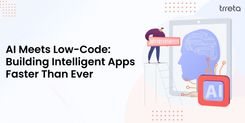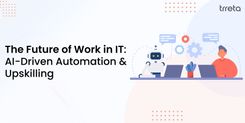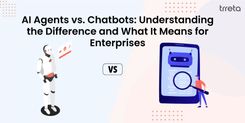The way we build applications is changing. Not too long ago, creating even a simple web or mobile app required months of development, large teams, and substantial budgets. Today, the rise of low-code platforms and artificial intelligence (AI) is rewriting those rules.
What used to demand thousands of lines of code can now be accomplished with drag-and-drop interfaces, visual workflows, and AI-driven automation. Businesses can move faster, experiment more, and deploy applications that are not just functional, but intelligent.
So what happens when you combine low-code development with AI capabilities? You get a powerful approach to building apps that require less manual coding but deliver more intelligent, adaptive, and user-centric solutions.
Let’s explore how this combination is shaping the future of application development.
What is Low-Code Development?
Low-code development refers to platforms and tools that allow applications to be built with minimal hand-coding. Instead of writing endless lines of code, developers (or even non-technical users) can use:
Visual drag-and-drop interfaces
Pre-built templates and modules
Workflow automation tools
Low-code isn’t about eliminating code entirely; it’s about reducing complexity and accelerating delivery. A developer might still write custom scripts where needed, but the bulk of the application is assembled visually.
Popular low-code platforms like Mendix, OutSystems, and Microsoft PowerApps have made it possible for businesses to quickly launch apps without relying solely on traditional development cycles.
Where AI Comes Into Play
Now, layer artificial intelligence on top of low-code, and things get even more interesting. AI extends low-code platforms by:
Automating repetitive tasks
Offering predictive insights
Enabling natural language processing (NLP)
Supporting personalization at scale
For example:
A retail app built with low-code can use AI to analyze customer behavior and recommend products.
A healthcare scheduling app can use AI to predict patient no-shows and optimize appointment slots.
A chatbot built into an HR app can use NLP to answer employee queries without manual intervention.
AI transforms low-code apps from being simply “functional” into being intelligent and adaptive.
Benefits of Combining AI and Low-Code
Bringing AI and low-code together creates a synergy that addresses modern business challenges. Here are the biggest advantages:
1. Faster Time-to-Market
Building an app traditionally takes months. With low-code, businesses can deploy prototypes within weeks. Add AI to automate processes, and you cut down the need for manual testing, bug fixing, and data handling — accelerating release cycles even further.
2. Democratization of Development
Low-code already makes it possible for “citizen developers” (non-technical users) to participate in app creation. AI enhances this by interpreting natural language inputs, auto-generating workflows, and guiding users through decision-making. This opens the door for more people within an organization to contribute to innovation.
3. Smarter User Experiences
AI-driven apps are not static; they learn and adapt. Whether it’s recommending content, predicting user actions, or personalizing dashboards, apps become more intuitive and user-friendly. This enhances customer satisfaction and boosts adoption.
4. Cost Efficiency
Low-code reduces the need for large teams, while AI reduces manual work. Together, they allow organizations to build scalable apps with fewer resources, lowering the overall cost of ownership.
5. Scalability and Flexibility
As businesses grow, their apps need to handle more users, more data, and more complexity. Low-code ensures quick scalability, while AI manages intelligent decision-making and automation — allowing apps to scale without human intervention.
Real-World Use Cases of AI + Low-Code
This combination is not just theory; it’s already being used across industries:
Healthcare: Low-code apps powered by AI chatbots are assisting patients with scheduling, answering FAQs, and even triaging symptoms.
Finance: AI-driven fraud detection integrated into low-code banking apps identifies unusual transactions in real time.
Retail & E-commerce: Recommendation engines built into low-code e-commerce platforms personalize shopping experiences.
HR & Recruitment: AI-enhanced HR apps can scan resumes, shortlist candidates, and even schedule interviews automatically.
Manufacturing: Predictive maintenance apps built on low-code with AI monitor equipment health and schedule repairs proactively.
These examples show how industries are not just saving development time, but also delivering smarter outcomes with less effort.
Challenges to Keep in Mind
While the combination of AI and low-code is powerful, it’s not without challenges:
Data Dependency: AI relies heavily on large volumes of high-quality data. Without it, predictions and insights may be flawed.
Customization Limits: Low-code platforms may have limitations in handling very complex or unique use cases.
Integration Issues: Combining low-code apps with legacy systems can sometimes require significant effort.
Skill Gaps: Even with low-code, businesses still need technical experts to manage AI models, data pipelines, and integrations.
Organizations need to balance speed with strategy, ensuring that apps are not just quickly built, but also robust and secure.
The Future of App Development: AI + Low-Code
We’re moving toward an era where building an application won’t require teams of specialized developers. Instead, business users, designers, and developers will collaborate on low-code platforms, guided by AI that automates the heavy lifting.
Imagine this: you describe the app you want in plain English, and the system — using AI — generates workflows, data models, and even UI screens. That’s not a distant dream; platforms are already moving in that direction.
The future will be about intelligent applications that adapt, learn, and evolve — all built with minimal coding effort.
Final Thoughts
The convergence of AI and low-code development is transforming how we think about building applications. Together, they reduce coding requirements, accelerate innovation, and inject intelligence into everyday business processes.
For organizations, this isn’t just a technical shift; it’s a strategic one. It means empowering more people to create, experiment, and innovate, while still ensuring that applications are scalable and future-ready.
Less code. More intelligence. Faster outcomes. That’s the future of application development — and it’s already here.




